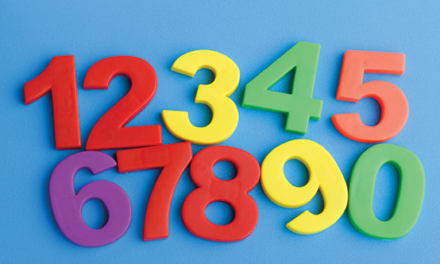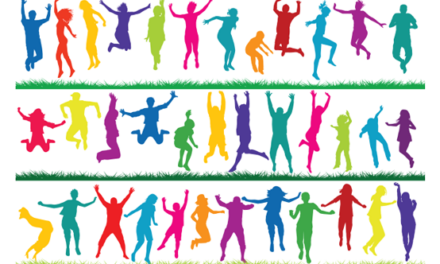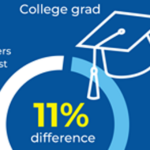
Can the prospect of public performance motivate student learning? One school found that it did.
Learning requires effort. One of the most challenging questions educators face is how to motivate students to put forth adequate effort. A potent source of such motivation is performing for an audience. Observant teachers and parents know that students put in substantial effort to master a skill or increase their knowledge in preparation for a performance. Young thespians stay up late and practice obsessively as opening day approaches. Budding scientists spend scores of hours perfecting their experiments before a science fair. Child musicians who seldom practice their instruments suddenly start practicing intensely before a recital.
Consider one author’s daughter who wanted to play the piano, but did not want to practice. During practice, she rushed through pieces, not bothering to stop and correct passages; she played badly and sighed and rolled her eyes if parents made her rework a section. She was content with slipshod work. However, a radical transformation occurred near recital time. She suddenly practiced intensely. She got up early to practice before school and practiced multiple times after school. She paid closer attention to her teacher. In every recital, she surprised her parents with how well she played.
This same motivation for performance applies to adults. For example, we know a former concert pianist who immigrated to the United States and no longer has a venue for performance. She occasionally rents a music hall and invites friends and neighbors to a self-hosted performance. She says she does this because she is motivated to practice more deliberately for a performance than when she is playing only for herself.
These observations raise several questions: Would the prospect of performance motivate children to increase their effort in learning? If so, how might this be implemented and sustained in school settings? We were able to explore these questions through a natural experiment at an elementary school that devised and implemented the Above and Beyond program.
Going above and beyond
Above and Beyond was a program for K-5 students at a Missouri inner city, art-oriented elementary school. Half (54%) of the students receive free/reduced-price lunches, many live in Section 8 housing, and 20% are black. The program derives its name from students going “above and beyond” the school curriculum. Students conducted creative learning projects of their own choosing, on their own time outside of school, following their own schedule.
Teachers and administrators were concerned that students were acting out themes of violence and sex on the playground, on buses, in the cafeteria, and in classrooms, mimicking what they saw watching TV and playing video games after school. In addition, the school was under pressure to increase state proficiency test scores, particularly in writing. In response to those concerns, the school developed Above and Beyond to:
- Reduce excessive time that students spent using media, much of it inappropriate, while increasing opportunities to learn outside of school;
- Increase writing skills; and
- Increase motivation at school so students would begin to feel ownership for their learning.
Participation was voluntary. Students could do as many or few projects as they wanted, but averaged three per year. Students generated project ideas themselves, but teachers could help students by providing examples. Each student had an adult mentor, a parent, other relative, teacher, or adult volunteer from the community. Students could choose learning projects based their (or their family’s) personal interests. Projects included writing components, such as a proposal and a personal reflection after the project was completed. Teachers encouraged students to explore their interests through various media, including art, music, movement, and technology. For example, a 2nd grader searched the Internet for information on hummingbirds. She found a report and rewrote it in her own words. Then she made an authentic (although overly large) nest of sticks, string, and grass, and filled it with clay eggs the size of real hummingbird eggs. In another case, a 2nd grader with the help of her father’s girlfriend created a quilt from patterns used by black slaves after becoming interested in the roots of jazz. They selected colors, purchased fabric, and sewed the quilt together. The students wrote about these projects and formally presented them to an audience of peers, parents, and teachers at weekly all-school assemblies. Each project was unique. There were no overt comparisons, no criteria for success, and no deadlines.

Income status and participation
Some teachers were skeptical that students from low-income homes would engage in learning activities after school. However, in the second year of implementation, 232 (69%) of the students completed 783 projects. Table 1 shows that participation was evenly spread across ethnicity and income status, contradicting teacher skepticism.
Initially, for example, teachers had been skeptical that William, a 3rd grader, would participate in any project that required after-school time. William had a reputation among teachers as being difficult to handle; he spent much of his time in a room for “redirection” of unruly children. He lived in poverty with his grandmother and several other children. He did not seem like a candidate for spending out-of-school time working on school-based learning projects. In fact, teachers struggled to get him to spend in-school time working on learning projects. Yet he and a friend decided to build an electric circuit for an Above and Beyond project. Their teacher connected them to an engineer in the community who collected spare parts for the project and served as their mentor. They successfully built a circuit that lit a light bulb. They then set to work developing a slide presentation of their project, which they presented at a school assembly.
Motivation
What motivated students like William to put effort into learning school-based subjects outside of school? Interviews with parents, students, and teachers revealed that major sources of motivation included stickers, praise from the principal, photo display, intrinsic interest, and, importantly, performance.
Stickers. Students could put a sticker in their “passport for learning” for each project they completed. A 1st-grade teacher said, “One wanted the stickers and reminded me every day, did you get my sticker? Did you get my sticker? Did you get my sticker? And I was like, OK, we got your sticker.” Teachers and parents believed stickers motivated only the youngest students, but not 4th and 5th graders. However, students in all grades said they were motivated by stickers. A 5th grader said, “It’s good to have stickers because it seems like you open your book . . . it’s like, whoa, that’s kind of cool because there’s a bunch . . . like stickers to help you remember everything.”
Praise from principal. Students were invited to the principal’s office when they completed a project. The principal admired their project and gave them a pat on the back. Teachers, parents, and students felt that recognition from the principal was highly motivating. A 5th-grade teacher said students think, “ ‘I got a couple minutes with my principal and assistant principal today and they told me I’m awesome!’ You know that’s pretty powerful.” A 2nd grader said showing her project to the principal “was like you get to show something to the president! It’s a real big privilege to go down to the principal’s just to get your picture taken and say hi.”
Photo display. Students had their picture taken when they completed a project. If the project involved building something tangible, the student was photographed with the product. Students, teachers, and parents reported that having one’s photograph displayed in the school hall motivated children. A 1st-grade teacher said, “Some of them, honestly, just wanted their picture on the wall. They wanted to be able to walk down the stairs at the end of the day and see their picture on the Above and Beyond bulletin board and say, ‘That’s me! I’m a part of my building!’ ”
Intrinsic interest. Some students chose topics for their projects that they found intrinsically interesting. A 5th-grade teacher said, “I had some students last year say, ‘Wow. I can’t believe I had fun at home without watching TV.’” A 1st-grade teacher said, “The only way we could get her to write was to make her fall in love with a project. And so when she found a project, she was like, ‘Oh, I’m going to do this.’ And she could follow a project through from beginning to end, so for her, it was that excitement of a project and seeing the completion of it.” A 5th grader spoke of his intrinsic interest: “I like it even if we didn’t have stickers and a passport book because I like being creative and just using the skills that I know how to use and coming up with different ideas.”
Performance. Parents, teachers, and students also felt that performance at the schoolwide assemblies was highly motivating. One parent from a low-income home said her daughter did projects “because the incentive was she got to stand there and deliver her speech in front of the school . . . even though she’s shy.” Another parent said performance “was huge. It was HUGE.” Another parent said, “He was always really excited about it, and that was the first thing he would tell me about when he got in the car after school.” A 5th-grade teacher said, “Some do it for the recognition. I mean some — their whole goal was to be recognized in assemblies.”
Decrease in Above and Beyond projects.
By chance, a natural experiment revealed in the third and final year of the program that public performance was the most powerfully motivating component. The first year had been a development year in which teachers, administrators, and students figured out how to implement the program. The second year was full implementation. The third year brought a change in school leadership and a decision to discontinue the all-school assemblies. Ironically, assemblies ended because of the program’s success. Students had become so enthusiastic about their public performance that sometimes there were 30 children in line to present at an assembly. New administrators felt this took too much instructional time. Children were told they could present their projects in their classes instead.
The other forms of recognition continued —stickers, a trip to the principal’s office, and photographs posted in the hallway. Yet participation nearly stopped completely. (See Figure 1.) A 3rd-grade teacher said, “I have had probably four Above and Beyonds this year but . . . last year, probably three or four a week.” One parent said, “Last year, it was awesome. This year, it’s completely different because . . . the kids are like, ‘why bother? We don’t have open-mike anymore either.’ ” A 4th grader said, “Showing what you did in the assembly for the entire school was much better than just the class.” This suggests that public performance was the strongest motivation for students. Thus, although other sources of motivation were present, program participation seemed to hinge primarily on public performance at all-school assemblies.

Performance and motivation theory
Encouraging student performances can be an effective strategy for increasing student motivation. While students, teachers, and parents reported that students were motivated by stickers, photograph display, performance, intrinsic interest, and praise from the principal, when performances were eliminated and the other motivating factors continued, student participation in Above and Beyond dropped precipitously. Thus, public performance seemed to be the critical component of motivation for most students.
Encouraging student performances can be an effective strategy for increasing student motivation.
Other extracurricular activities also have a public performance component and also motivate students to put in considerable effort to learn and master skills. These activities include sports, debate tournaments, music festivals, and academic competitions (e.g., Mathcounts, Odyssey of the Mind, Math Olympiad). Since many such activities also have a competitive element, separating the motivational role of competition from performance can be difficult. Competition is about performing better than others. Research has sometimes shown that competition can undermine motivation — usually when the learner’s focus is completely on winning or avoiding losing. In contrast, when combined with mastery goals, holding competitive goals can promote effort and learning (Linnenbrink-Garcia et al., 2012; Murayama & Elliott, 2012; Senko, Hulleman, & Harackiewicz, 2011). Mastery goals are intended to prompt students to acquire skills and develop competencies. They are most effective when students have a preference for deep learning and challenge, the willingness to seek help, and a genuine interest in their subject. Thus, in some situations, it is ideal to simultaneously hold goals to master a topic and also to perform better than others. Observers of youth competitions describe amazing feats of concentration, problem solving, and performance (Dutton, 2011). Consider 8th grader Ian, who competed in Mathcounts but didn’t place in the top 10 at nationals. “He bought several books of Olympiad-level problems and began working his way through them. Sometimes he would struggle over a single problem for hours, but he told himself that it was good training. He took a math class at Princeton, and he read his father’s old college textbooks” (Olson, 2004, p. 85).
In our interviews of Above and Beyond participants, not a single comment was made about out-performing others or comparison to other students.
Students can participate in competitions for noncompetitive reasons, that is without focusing on winning or even on doing better than others. Consider math competitions and cross-country meets. Most participants know before the competition even begins that they will not come in first. Only a few elite participants are actually competing to win; the rest are participating for other reasons, like improving their performance or improving their skills. Thus, for many student competitors, the motivating element may be performance rather than competition per se. The Above and Beyond natural experiment suggests that the public performance motivates students to engage in challenging learning and elevates their performance. In our interviews of Above and Beyond participants, not a single comment was made about out-performing others or comparison to other students.
Let’s revisit the girl who intensely practiced the piano only before a performance. Was her goal to do better than others? Was she concerned about comparison with other pianists? Probably not, because group recitals don’t stress comparison, and many of her recitals were solo performances. She was probably motivated to perform well and to avoid making mistakes.
Implications for schools
Public performance can motivate students to engage in challenging practice and learning, even in after-school hours. Specific aspects of public performance that may motivate include the following:
- Students choose to perform in areas that interest them (Bergin, 1999);
- Their choice of whether and how to participate allows them a measure of autonomy (Ryan & Deci, 2000);
- Students can choose from different types of performance that highlight different types of abilities (Cohen & Lotan, 1995); and
- Students set goals to prepare for their performance (Locke & Latham, 1990).
While many schools provide opportunities for public performance, these typically occur in extracurricular activities like drama, sports, quiz bowls, band, and Future Farmers of America, and many are competitive. Our interviews and observations with teachers, students, and parents in the Above and Beyond program suggest schools should expand opportunities for public performance in school and do so under conditions where neither assessment nor overt comparison plays a salient role.
References
Bergin, D.A. (1999). Influences on classroom interest. Educational Psychologist, 34 (2), 87-98.
Cohen, E.G. & Lotan, R.A. (1995). Producing equal-status interaction in the heterogeneous classroom. American Educational Research Journal, 32 (1), 99-120.
Dutton, J. (2011). Science fair season. New York, NY: Hyperion.
Linnenbrink-Garcia, L., Middleton, M.J., Ciani, K.D., Easter, M.A., O’Keefe, P.A., & Zusho, A. (2012). The strength of the relation between performance-approach and performance-avoidance goal orientations: Theoretical, methodological, and instructional implications. Educational Psychologist, 47 (4), 281-301.
Locke, E.A. & Latham, G.P. (1990). A theory of goal setting and task performance. Englewood Cliffs, NJ: Prentice-Hall.
Murayama, K. & Elliot, A.J. (2012). The competition–performance relation: A meta-analytic review and test of the opposing processes model of competition and performance. Psychological Bulletin, 138 (6), 1035-1070.
Olson, S. (2004). Countdown: Six kids vie for glory at the world’s toughest math competition. New York, NY: Houghton Mifflin.
Ryan, R.M. & Deci, E.L. (2000). Self-determination theory and the facilitation of intrinsic motivation, social development, and well-being. American Psychologist, 55, 68-78.
Senko, C., Hulleman, C.S., & Harackiewicz, J.M. (2011). Achievement goal theory at the crossroads: Old controversies, current challenges, and new directions. Educational Psychologist, 46 (1), 26-47.
Citation: Bergin, D., Bergin, C.C., Van Dover, T., & Murphy, B. (2013). Learn more: Show what you know. Phi Delta Kappan, 95 (1), 54-60.
ABOUT THE AUTHORS

Bridget Murphy
BRIDGET MURPHY is a research coordinator in the College of Education at the University of Missouri, Columbia, Mo.

Christi Crosby Bergin
CHRISTI CROSBY BERGIN is an associate research professor in the College of Education at the University of Missouri, Columbia, Mo. She and David Bergin are coauthors of Child and Adolescent Behavior in your Classroom .

David Bergin
DAVID BERGIN is an associate professor and director of graduate studies in the College of Education at the University of Missouri, Columbia, Mo. He and Christi Crosby Bergin are coauthors of Child and Adolescent Behavior in your Classroom .

Teresa Van Dover
TERESA VAN DOVER is an associate professor at Columbia College, Columbia, Mo.










